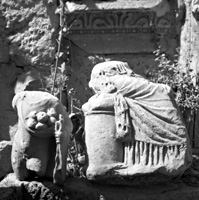 MAMA XI 188 (Synnada)
MAMA XI 188 (Synnada) 
Sculptural fragment of a seated female figure
- Type of monument:
- Sculptural fragment from sarcophagus.
- Location:
- Şuhut (Synnada): in the yard of a mill, with MAMA XI 189 (1955/8).
- Description:
- White marble female figure, fully draped in a mantle, seated on a cylindrical cippus. The body is broken off at the waist. At a later date the figure of a lion was carved on the back of the body.
- Dimensions:
-
Ht. 0.53+; W. 0.47; Th. 0.19.
- Record:
- MB notebook copy; drawing; photograph (1955/9).
- Publication:
- None.
- Date:
- Late second century AD.
-
-
 MAMA XI 188 (Synnada)
MAMA XI 188 (Synnada) 





This seated figure derives from a well-known sarcophagus-type, produced at Dokimeion for local consumption in Phrygia, Pisidia and Lykaonia, with the so-called ‘Lykian motif’ of wife and husband seated facing one another, flanking a tabula ansata carrying the funerary inscription. Several other examples are known on which the wife is depicted seated on a cylindrical cippus: see Waelkens 1982: 57-9 (esp. no. 5, Konya L 1 [Dondurma]); Özgan 2000: 376-87 (examples from Konya; Afyon; Beyşehir; Yalvaç); Özgan 2003: 47-51, Kat. 14 (Konya), 15 (Dondurma). In the inscription on the Konya sarcophagus (SEG 50, 1358bis; I.Konya 182), the monument is explicitly described as being of Dokimeian origin (τὴν σορὸν Δοκιμηνήν); see further Hall and Waelkens 1982.
Sarcophagi of this type are dated by Waelkens 1982: 57 to c. AD 155-170 on the basis of stylistic similarities to other products of the Dokimeion workshop. Özgan 2000: 383-7 prefers a date in the late third century, but the inscription on the Konya sarcophagus seems rather to support a late second- or early third-century date (E. Schwertheim, in Özgan 2003: 87).